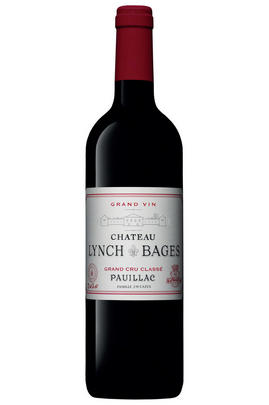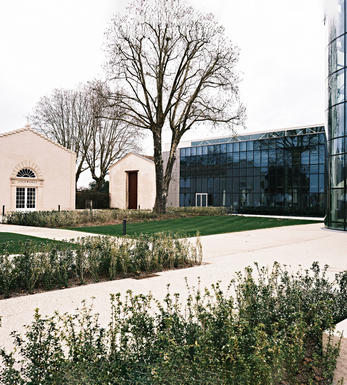
2020 Château Lynch-Bages, Pauillac, Bordeaux

Critics reviews
Drink from 2027 to 2055
Neal Martin, Vinous (May 2021)
Drink from 2025 to 2050
Antonio Galloni, Vinous (June 2021)
Drink from 2030 to 2048
Jane Anson, Decanter (April 2021)
Drink 2027 - 2050
Lisa Perrotti-Brown MW, Wine Advocate (May 2021)
Drink 2031 - 2049
Jancis Robinson MW, JancisRobinson.com (April 2021)
James Suckling, jamessuckling.com (April 2021)
Jeb Dunnuck, jebdunnuck.com (May 2021)
Drink 2030 - 2050
Michael Schuster, The World of Fine Wine (May 2021)
About this WINE

Chateau Lynch-Bages
Château Lynch Bages, a 5ème Cru Classé, is one of the best-known Médoc estates and has always had a particularly strong following on this side of the English Channel. Since 1973 it has been owned by the enigmatic Jean-Michel Cazes and is now run by his son, Jean-Charles.
Lynch Bages's vineyards are superbly sited on a plateau west of Pauillac town, in the small village of Bages. The 90 hectares of vineyards (Red: Cabernet Sauvignon 75%, Merlot 15%, Cabernet Franc 10%) lie on deep gravel beds over limestone. For the reds, fermentation is temperature-controlled with extensive 'remontage' to ensure concentration and depth of colour. A special system of pipes transfers the wine from the cuves to the oak barriques (60% new) where it matures for 15 months.
Lynch Bages can be surprisingly soft and approachable when young. However, when fully mature, it develops a succulent richness and a heavenly bouquet of minty blackcurrants and cigar boxes. As Oz Clarke says "Lynch Bages is impressive at five years, beautiful at ten years and irresistible at twenty."

Pauillac
Pauillac is the aristocrat of the Médoc boasting boasting 75 percent of the region’s First Growths and with Grand Cru Classés representing 84 percent of Pauillac's production.
For a small town, surrounded by so many familiar and regal names, Pauillac imparts a slightly seedy impression. There are no grand hotels or restaurants – with the honourable exception of the establishments owned by Jean-Michel Cazes – rather a small port and yacht harbour, and a dominant petrochemical plant.
Yet outside the town, , there is arguably the greatest concentration of fabulous vineyards throughout all Bordeaux, including three of the five First Growths. Bordering St Estèphe to the north and St Julien to the south, Pauillac has fine, deep gravel soils with important iron and marl deposits, and a subtle, softly-rolling landscape, cut by a series of small streams running into the Gironde. The vineyards are located on two gravel-rich plateaux, one to the northwest of the town of Pauillac and the other to the south, with the vines reaching a greater depth than anywhere else in the Médoc.
Pauillac's first growths each have their own unique characteristics; Lafite Rothschild, tucked in the northern part of Pauillac on the St Estèphe border, produces Pauillac's most aromatically complex and subtly-flavoured wine. Mouton Rothschild's vineyards lie on a well-drained gravel ridge and - with its high percentage of Cabernet Sauvignon - can produce (in its best years) Pauillac's most decadently rich, fleshy and exotic wine.
Latour, arguably Bordeaux's most consistent First Growth, is located in southern Pauillac next to St Julien. Its soil is gravel-rich with superb drainage, and Latour's vines penetrate as far as five metres into the soil. It produces perhaps the most long-lived wines of the Médoc.
Recommended Châteaux
Ch. Lafite-Rothschild, Ch. Latour, Ch. Mouton-Rothschild, Ch. Pichon-Longueville Baron, Ch. Pichon Longueville Comtesse de Lalande, Ch. Lynch-Bages, Ch. Grand-Puy-Lacoste, Ch, Pontet-Canet, Les Forts de Latour, Ch. Haut-Batailley, Ch. Batailley, Ch. Haut-Bages Libéral.

Cabernet Sauvignon Blend
Cabernet Sauvignon lends itself particularly well in blends with Merlot. This is actually the archetypal Bordeaux blend, though in different proportions in the sub-regions and sometimes topped up with Cabernet Franc, Malbec, and Petit Verdot.
In the Médoc and Graves the percentage of Cabernet Sauvignon in the blend can range from 95% (Mouton-Rothschild) to as low as 40%. It is particularly suited to the dry, warm, free- draining, gravel-rich soils and is responsible for the redolent cassis characteristics as well as the depth of colour, tannic structure and pronounced acidity of Médoc wines. However 100% Cabernet Sauvignon wines can be slightly hollow-tasting in the middle palate and Merlot with its generous, fleshy fruit flavours acts as a perfect foil by filling in this cavity.
In St-Emilion and Pomerol, the blends are Merlot dominated as Cabernet Sauvignon can struggle to ripen there - when it is included, it adds structure and body to the wine. Sassicaia is the most famous Bordeaux blend in Italy and has spawned many imitations, whereby the blend is now firmly established in the New World and particularly in California and Australia.


Buying options
Add to wishlist
Description
At last Lynch-Bages has its new cellar. It’s airy, functional and striking, designed to give maximum flexibility to adapt to the château’s detailed vineyard analyses. Immediately of note is the energy and clarity that this inaugural vintage here presents. Among the signature Lynch-Bages notes of cassis and tobacco, there are also perfumes of rose and violet. The palate rounds out and finishes with precision and sapid freshness, perhaps aided by the notably restrained alcohol of 13.41% (the label will have to say 13.5%).
Drink 2028-2050
wine at a glance
Delivery and quality guarantee